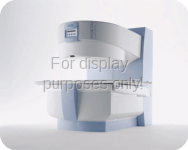The Siemens 0.2T Concerto MRI is an open, low-field magnetic resonance imaging system. It is tailored for whole-body diagnostics. It was introduced by Siemens Healthineers. The machine built around a permanent magnet with a field strength of 0.2 Tesla. That makes it a cost-effective alternative to the more common high-field systems (like 1.5T or 3T).
Its standout feature is the open design. Three-sided, with no closed tunnel. This makes it a go-to for patients who struggle with claustrophobia, anxiety or physical constraints like obesity or mobility issues. The openness also reduces noise levels compared to traditional MRIs, which is better for the overall patient experience.
Application
-
Musculoskeletal (MSK) Imaging:
-
Joint evaluations (shoulder, knee, wrist), tendon/ligament tears, and osteoarthritis.
-
Preferred for post-surgical monitoring (e.g., ACL repairs).
-
-
Interventional MRI:
-
Real-time guidance for biopsies, pain management injections, or tumor ablations.
-
Open design allows physician access during procedures.
-
-
Pediatric & Claustrophobic Patients:
-
Reduced anxiety due to open configuration.
-
-
Orthopedic & Outpatient Clinics:
-
Cost-effective for high-volume MSK studies.
-
Limitations
-
Not ideal for neuroimaging (limited brain/spinal cord detail) or abdominal imaging (motion artifacts).
-
Poor performance for cardiac MRI or functional MRI (fMRI).
Advantages
-
Patient Comfort:
-
Open design minimizes claustrophobia and accommodates larger body types.
-
Quieter operation compared to high-field systems.
-
-
Safety:
-
Lower SAR reduces RF heating risks.
-
Reduced metal artifact susceptibility (e.g., safer for patients with non-ferromagnetic implants).
-
-
Cost & Maintenance:
-
Lower upfront cost (~500,000–500,000–1 million USD vs. $1–3 million for 1.5T).
-
No helium dependency, reducing long-term maintenance expenses.
-
Compact footprint suits smaller clinics.
-
Spec
MRI Type: Siemens 0.2T Concerto MRI
Year of Manufacture: 2003
Magnet Type: Permanent Magnet
Coils: All coils are phased array and include Head, Neck, Body, Spine, Quadrature Extremity and Small Coil
Software: NUMARIS 3, Turbo Imaging Software, MRease / Syngo Windows, NT Software
Various: C-Shape Design


